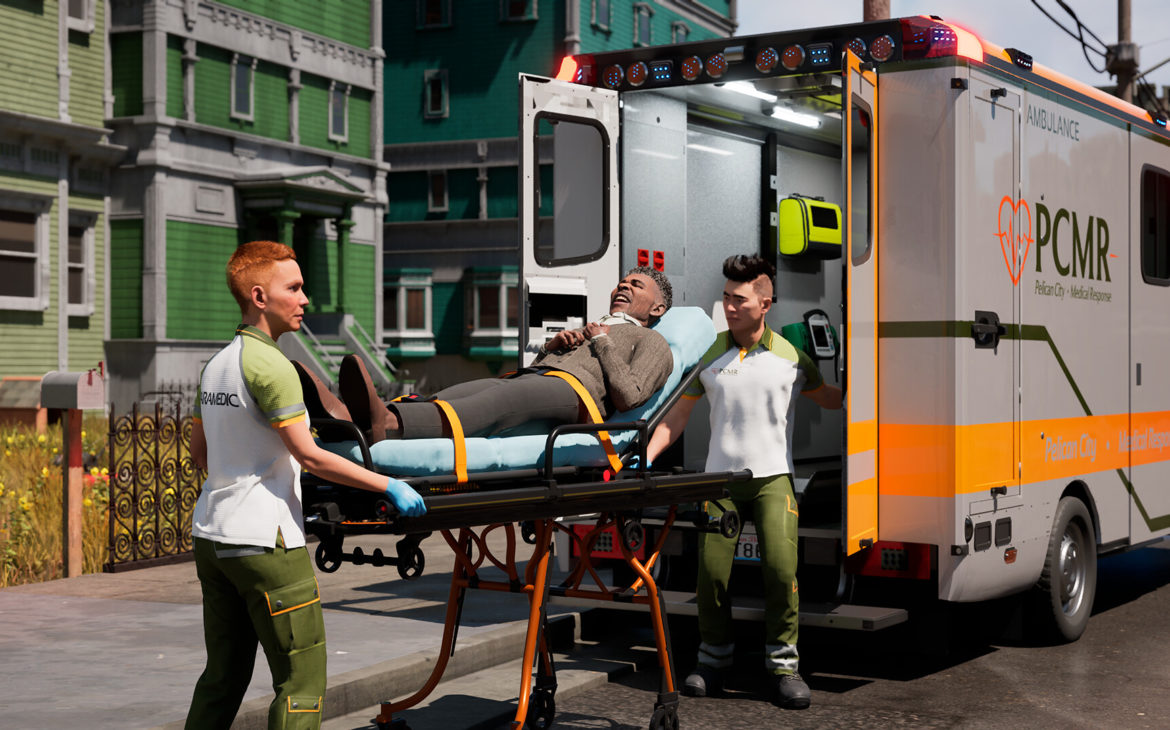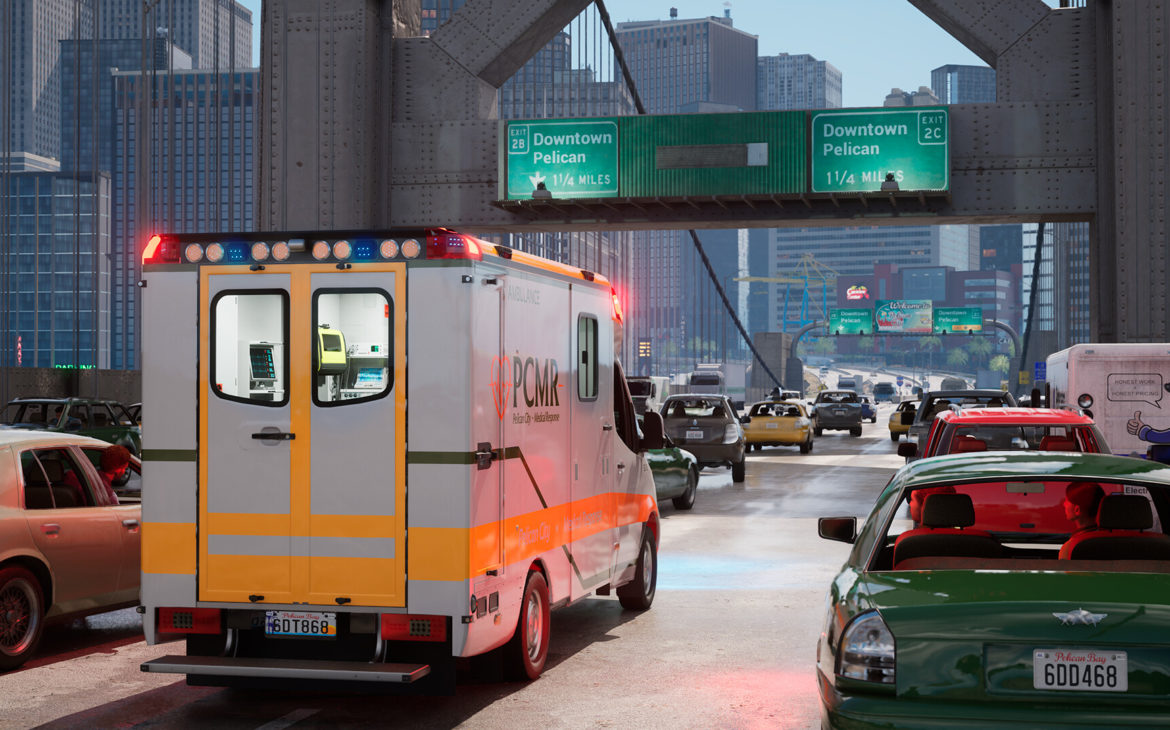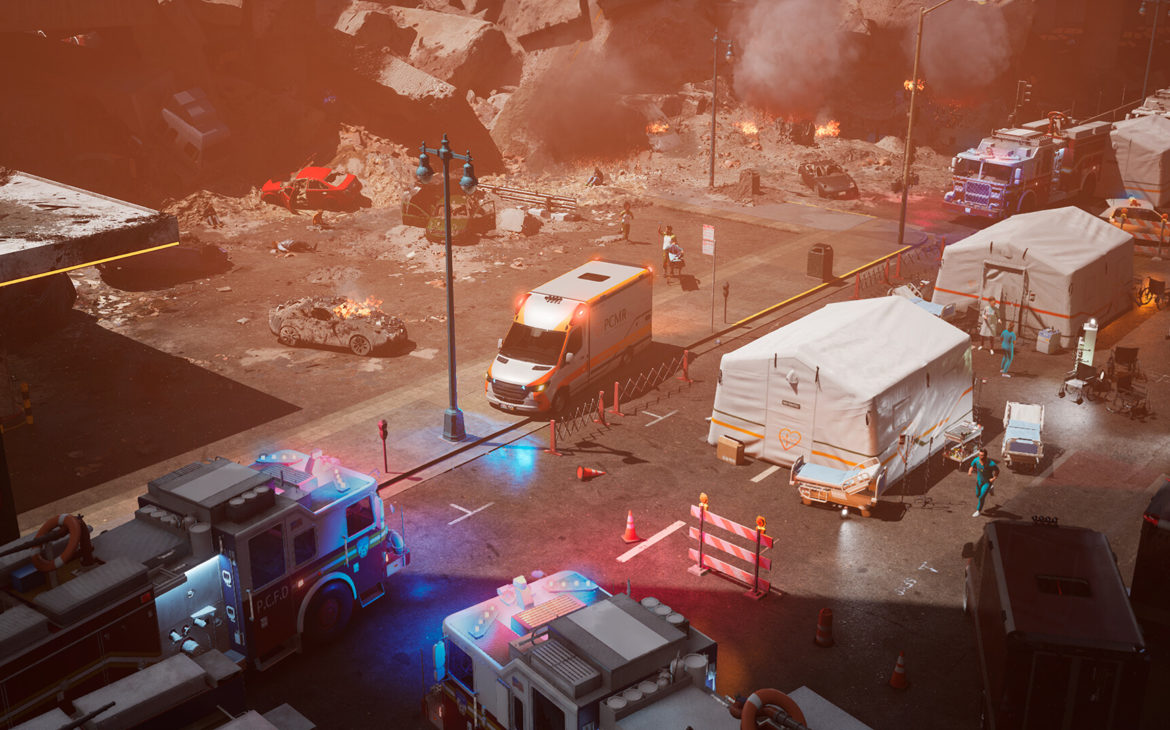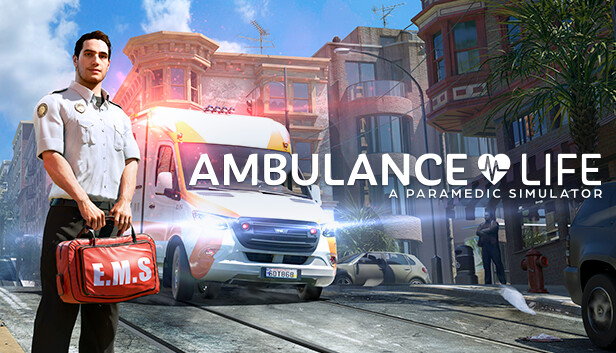Fun fact (okay, maybe not ‘fun’?): I nearly trained as a paramedic shortly before COVID. I have always been incredibly grateful for the NHS, and the paramedics who do such a stellar job. Every paramedic-type show has me on the edge of my seat. Ambulance Life: A Paramedic Simulator was an easy yes to checking it out. Is it a lifesaving experience? Or DOA?
The Bright Lights and Loud Sirens
Ambulance Life: A Paramedic Simulator is an immersive and intense simulation game that offers players the unique opportunity to step into the shoes of a paramedic. Players will respond to call-outs, assess patients, triage emergencies, drive, and provide (hopefully) the best treatment to allow your patient to have a safe and stable journey to the hospital. Rinse, Receive Call, Repeat.
If you think Ambulance Life: A Paramedic Simulator takes on the tone of Surgeon Simulator where you’ll have someone’s kidney flailing about in your hands whilst simultaneously grasping at the gurney so they don’t slide out onto the road, you’re going to be very disappointed.
Ambulance Life takes on a much more serious tone but tries to keep things as varied as possible. No day will be the same and there are lots of mechanics to learn. At first, this may feel overwhelming and time pressured, but like any job training eventually becomes second nature. You know how like… people are pretty confident they can land a plane IF an emergency occurred? Yeah, I am pretty confident that should for whatever unknown strange reason, a paramedic not be able to fulfil their duty – I could perhaps confidently… assist. At the very least.
Whilst the driving mechanics are functional, they do give off, basic. However, this is absolutely fine and what is needed. You flash your sirens, you beep your horn and you can fly down the road. I think the issue here with driving is the traffic AI. Apparently, the traffic is supposed to move out of the way for you when sirens are ablaze. Whilst this happened on a few occasions, it was extremely inconsistent. Often forcing me to just side swipe or drive straight into cars to get them to move. Sometimes, instead of getting out of the way, it’s as if the cars were all actually playing a secret unspoken game of frozen statues and we must not move.
In fact, a new bonus level was added where not only should we not move but we should make it our mission to make it as difficult as possible for the ambulance to navigate around this giant line of traffic. I think I had more conversations with the traffic than I did with my own patients. Alas, this is not “How to drive the ambulance simulator” and not where the engagement is. The medical side is where the game becomes the most engaging. Using a range of tools, processes and procedures, players must assess, diagnose and stabilise. It starts with the call out, which leads to you driving to the scene.

Scene Partner
At the scene of the incident, you’ll need to talk to your patient and ask a series of questions for information. Whilst there are many scenarios and health conditions you can find your patient in, the script in locations can feel quite repetitive. What in the 1920s is going on when every panic attack is about a divorce? People celebrate with cakes now, let’s catch up. Also, why are we giving ketamine to said panic attack patients? Whilst I am not here to judge America’s health system – and whilst I am not a doctor (yet) – I feel pretty confident that shouldn’t be the treatment anyone is pushing for mental health.
Why is the police officer, who is attending the scene, either their neighbour or randomly knows them? You can talk to witnesses but I can’t say I have ever had a single shred of helpful information from anyone who I have asked. They either didn’t see anything, they’re the neighbour, or ‘they look worse’.
You can toggle to observe physiological symptoms to garner more information for your tentative diagnosis and this will help guide your treatment. Once there’s been a little roadside checkover, you’ll move to the stretcher and place them in the ambulance. The stretcher control is somehow worse than the traffic, but for the very short ride you take in it, we will leave it there.
Once in the ambulance, you’ll need to take an initial bunch of observations to start with. What you choose to do and monitor is kind of at your own disposal, but it’s good to go with the basics first such as O2 saturation to check oxygen levels, blood pressure cuffs, and glucose levels.
At first, this can feel pretty daunting. While the game doesn’t throw everything at you and does ease you in, you still need to act quickly. Some observed signs such as someone spurting blood, will – if not treated fast enough – lead to that person becoming unresponsive. That’s about as helpful as the witnesses around so act quickly.

Every Second Counts
In praise, there are so many potential things to do, check and use to treat wounds, ailments and stabilise. It would be hard to say it lacks a breadth of mechanics to its namesake. If you do become lost, there is a manual to hand, similar to those that paramedics carry to monitor patients who have it all. It will have the current stats tracked on the client, the symptoms observed, and this is where you can start to make a tentative diagnosis.
Diagnosis is based on what you’ve observed. Probability markers will allow you to keep track of what the likely diagnosis could be. However, if you haven’t been thorough your chances of being accurate could be low. The manual also has every potential diagnosis you can observe in the game, how it would be treated in the game, and information on it. It also has a play-by-play of all the tools that can be at your disposal, including machinery like a ventilator, or the plethora of medications you carry as “preventative medicine” (sorry, I still can’t get over the ketamine thing?).
Whilst sometimes the controls are extremely clunky, it works. Every time I put a mask on though the wires would flail everywhere – that was the only throwback to the surgeon simulator I saw but I’m not sure it was the intention, to be honest. Character models can lack detail, animations can be stiff – especially in patient interaction – and environments are serviceable. The sound design is a mixed bag, the sirens and radio can be quite immersive, but the voice acting can land unconvincing and a bit robotic.
Balancing realism and accessibility is a tricky task with the simulation genre and whilst Ambulance tries to adopt a more serious tone, the ease of simplifying procedures for the sake of playability is smart. It makes it approachable for casual players, and hardcore adrenaline junkies can always up the ante in the settings, should they want more pressure on time, and higher stakes to stabilise patients.
Your shifts are a minimum of 15 minutes, longer when you progress through the game. A lot of gameplay at once can become slightly monotonous if the same conditions are coming up, especially when it comes to the repetitive script and almost the same location for the same subtype of problem. When shifts get boring you can jump into a ‘Catastrophic Event’. This was actually kind of fun and added a new layer to the systems I’d learned.
Players will arrive at the scene of a major incident. Your first incident is the collapse of the highway bridge. Tens of cars have collapsed through the bridge, explosions, fire, bodies – everywhere. This section is in two parts. Your first job is you have a short time limit to find everyone and triage them. Black for decreased, green for walking wounded, yellow for urgent but could wait, and red for emergency. You have to work quickly, and score as fast as you can. You may have to complete some roadside medical care like fitting tourniquets.
After this has been done, you’ll receive a handful of your triaged clients who you likely scored yellow and you’ll need to treat and stabilise as fast as possible. On my first go at this, I had someone flatline on me, and I had to abandon everyone to rush this guy to the hospital. Your second in command will begin CPR and you may need to pass instructions whilst also driving. The second and third time, I managed to save everyone. It’s a mixture of variety that is very welcome in simulator games.

A Crisis of Understanding
Beyond this, there’s not much else to talk about. I will say, this game has to be played with caution. Everyone will know someone who has received medical help at one point in their life. Whilst Ambulance Life: A Paramedic Simulator attempts – with a lot of simplicity – to add realism to most conditions and their treatment, those who are affected by those conditions may feel it’s taken on a shallow approach.
What it needs to absolutely back away from immediately is the insensitive and tone deaf approach it took on mental health. The game is designed to resemble the US, but in the context of this review being written from the UK, 10% of daily calls to London ambulance services are mental health related. That’s one capital city of a floating island, where the very country this is based in is 40x bigger than that country and has 5x the population.
Cool. Now we have our facts. I am going to perhaps take a wild guess, and suggest Mental Health in the US likely has a significant percentage of callouts asking for emergency medical assistance there too, based on those numbers.
Ambulance Life: A Paramedic Simulator is likely the most rudimentary and egregious take on mental health I have ever seen a game portray. I came across my first ‘suicide call out’. Tell me why, instead of what one may naturally assume this would be someone in distress or someone in their apartment or house struggling, or something to perhaps that effect… I instead attended the bottom of a highway intersection bridge to find a character literally lying in a pool of their own blood. The witness says something unhelpful (shocker), and your patient tells you something along the lines of ‘he’s sorry but it won’t be the end of this.’ When talking with patients, you usually have the option to ‘intervene’ and attempt to initiate calming techniques. You guessed it, that wasn’t an option here. Why? Absolutely beats me.
Why was this not an option here? Arguably on the condition that needed that intervention the most? The conversation goes no further from the not-so-subtle information that this character will attempt their life again and you’ll put them in the ambulance. If you’re trying to portray paramedics as cold-hearted monsters that had more sympathy towards hitting the kerb on the way to the patient, than to the patient themselves, then congratulations. Let me give you your medal and contact The Game Awards for ‘Games for Impact’.
Meanwhile, I do my job, get him into the ambulance to check him over properly, hoping, praying that something is about to change. They display his symptoms as those consistent with broken bones, trouble breathing, etc. But no wait, what’s this? Oh having this ‘storyline’, ‘character’ whatever you wish to call it, jump off of a highway bridge wasn’t enough of an indication of suicide? No? Oh, that’s right, the character model has his wrists cut too.
Sorry, I didn’t realise I was transported back into the early 2000s with shallow, damaging and superficial stigmatisation of mental health. Bit much no? I’ve seen many games try, succeed and fail to attempt to tackle mental health difficulties within various elements of the game, whether that be lore, storyline, character, or main plot of the game. Sometimes it goes wrong, sometimes it walks the line of inappropriate. At times it adds to the stigma of mental health, and at other times players will pour their soul into the community of a game because they relate to its characters’ story; but how has this flagrant gross portrayal ever made it into a simulation game, is beyond every fibre of my soul.
There is a way to do this, that attends to all angles. It’s the tone deaf ignorance that many players are experiencing, managing, and trying to cope with their own mental health. I’m not about to turn this into an Op-Ed on mental health in gaming, but not even an option to turn it off? A trigger warning? A content warning? No? Okay.
It reeks of being uninformed of the realities of mental health and the impact it has – in the same breath as trying to represent a simulation of a paramedics experience. If you can’t do it, don’t do it. I have not yet even mentioned the patient in question was a male. The blatent demonstration and adding to the stigma of not only mental health, but men’s mental health. That was a callous, and barbaric choice made in the wake of an already very under discussed topic and an embarrassing level of insensitivity.
In summary, Ambulance Life: A Paramedic Simulator aims to provide a realistic experience of medical emergency response. It attempts to capture urgency and unpredictability in the job. Whilst an average enjoyable time in some places, its portrayal of mental health emergencies reduces complex and nuanced situations with the delicacy of a sledgehammer. Despite its ambition, the game’s lack of depth undercuts its attempt at authenticity.
Ambulance Life: A Paramedic Simulator is available now on PlayStation 5, Xbox Series S|X, and PC via Steam
Developer: Aesir Interactive
Publisher: Nacon
Disclaimer: In order to complete this review, we were provided with a promotional copy of the game. For our full review policy, please go here.
If you enjoyed this article or any more of our content, please consider our Patreon.
Make sure to follow Finger Guns on our social channels –Twitter, Facebook, Twitch, Spotify or Apple Podcasts – to keep up to date on our news, reviews and features.
